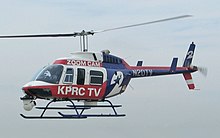Helicopter
[citation needed] US Federal regulations state that "helicopter" means a rotorcraft that, for its horizontal motion, depends principally on its engine-driven rotors.There are several common configurations that use the counter-rotating effect to benefit the rotorcraft: Tip jet designs let the rotor push itself through the air and avoid generating torque.[citation needed] Some radio-controlled helicopters and smaller, helicopter-type unmanned aerial vehicles, use electric motors or motorcycle engines.Applying forward pressure on the cyclic will cause the nose to pitch down, with a resultant increase in airspeed and loss of altitude.Helicopters are used as aerial cranes in the logging industry to lift trees out of terrain where vehicles cannot travel and where environmental concerns prohibit the building of roads.In military operations these payloads are often delivered to remote locations made inaccessible by mountainous or riverine terrain, or naval vessels at sea.[32] In naval service a prime function of rescue helicopters is to promptly retrieve downed aircrew involved in crashes occurring upon launch or recovery aboard aircraft carriers.[36] The 4th-century AD Daoist book Baopuzi by Ge Hong (抱朴子 "Master who Embraces Simplicity") reportedly describes some of the ideas inherent to rotary wing aircraft.[42] It was not until the early 1480s, when Italian polymath Leonardo da Vinci created a design for a machine that could be described as an "aerial screw", that any recorded advancement was made towards vertical flight.His notes suggested that he built small flying models, but there were no indications for any provision to stop the rotor from making the craft rotate.In 1783, Christian de Launoy, and his mechanic, Bienvenu, used a coaxial version of the Chinese top in a model consisting of contrarotating turkey flight feathers[42] as rotor blades, and in 1784, demonstrated it to the French Academy of Sciences.Sir George Cayley, influenced by a childhood fascination with the Chinese flying top, developed a model of feathers, similar to that of Launoy and Bienvenu, but powered by rubber bands.[45] In 1861, the word "helicopter" was coined by Gustave de Ponton d'Amécourt, a French inventor who demonstrated a small steam-powered model.Edison built a helicopter and used the paper for a stock ticker to create guncotton, with which he attempted to power an internal combustion engine.[50] Ján Bahýľ, a Slovak inventor, adapted the internal combustion engine to power his helicopter model that reached a height of 0.5 meters (1.6 feet) in 1901.[51] In 1908, Edison patented his own design for a helicopter powered by a gasoline engine with box kites attached to a mast by cables for a rotor,[52] but it never flew.[citation needed] In the early 1920s, Argentine Raúl Pateras-Pescara de Castelluccio, while working in Europe, demonstrated one of the first successful applications of cyclic pitch.[60][61] In March 1923 Time magazine reported Thomas Edison sent George de Bothezat a congratulations for a successful helicopter test flight.His first prototype "flew" ("hopped" and hovered in reality) on 24 September 1925,[66] with Dutch Army-Air arm Captain Floris Albert van Heijst at the controls.[citation needed] In 1927,[69] Engelbert Zaschka from Germany built a helicopter, equipped with two rotors, in which a gyroscope was used to increase stability and serves as an energy accumulator for a gliding flight to make a landing.[70][71] In 1928, Hungarian aviation engineer Oszkár Asbóth constructed a helicopter prototype that took off and landed at least 182 times, with a maximum single flight duration of 53 minutes.Control was achieved by using auxiliary wings or servo-tabs on the trailing edges of the blades,[74] a concept that was later adopted by other helicopter designers, including Bleeker and Kaman.Powered by two M-2 powerplants, up-rated copies of the Gnome Monosoupape 9 Type B-2 100 CV output rotary engine of World War I, the TsAGI 1-EA made several low altitude flights.It flew in Sint-Genesius-Rode, at the Laboratoire Aérotechnique de Belgique (now von Karman Institute) in April 1933, and attained an altitude of six meters (20 feet) and an endurance of eight minutes.[87] American inventor Arthur M. Young started work on model helicopters in 1928 using converted electric hover motors to drive the rotor head.[88] Heinrich Focke at Focke-Wulf had purchased a license from Cierva Autogiro Company, which according to Frank Kingston Smith Sr., included "the fully controllable cyclic/collective pitch hub system".The R-4 was the only Allied helicopter to serve in World War II, used primarily for search and rescue (by the USAAF 1st Air Commando Group) in the Burma campaign;[95] in Alaska; and in other areas with harsh terrain.The availability of lightweight turboshaft engines in the second half of the 20th century led to the development of larger, faster, and higher-performance helicopters.The redesigns followed the closure of some city heliports and government action to constrain flight paths in national parks and other places of natural beauty.In-flight catastrophic gear failures often result in gearbox jamming and subsequent fatalities, whereas loss of lubrication can trigger onboard fire.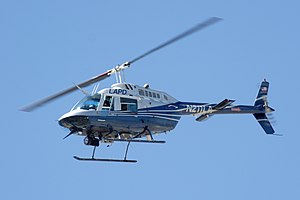







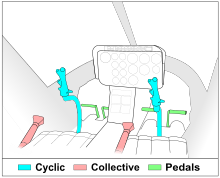




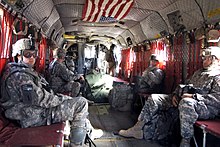
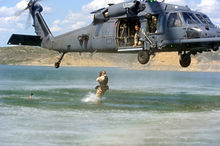



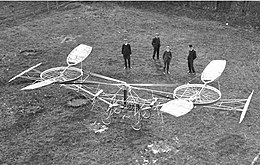


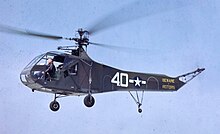






Helicopter (disambiguation)Bell 206Los Angeles Police DepartmentAir Support Divisionrotorcraftthrustrotorstake off and land verticallyfixed-wing aircraftrunwaySikorsky R-4productionmain rotortail rotormonocoptertandemtransverse rotorscoaxial-rotortiltrotorcompound helicoptersquadcoptersas early as 1907multicoptersunmanned aerial vehiclesdrone racingaerial photographymarketsweaponizedartillery spottingaerial bombingsuicide attacksrebracketingUnited StatesautogyrogyrodyneHelicopter rotoraerodynamic dragIgor SikorskyVS-300ducted fanFenestronCoandă effectMD 520NTandem rotorstiltrotorsCoaxial rotorsIntermeshing rotorsMultirotorsquadcopterdronesTip jetAircraft engineTurboshaftCH-53 Sea Stallioninternal combustion enginerotary enginesradial enginesflat enginetip jetsSud-Ouest DjinnYH-32 Hornetradio-controlled helicopterselectric motorspiston engineshuman-powered helicopterstransmissionbearingsclutchesshaftsdrive shaftdrivetrainbevel gearsturbine enginesreduction gearsplanetary gearshelical gearsspur gearsautorotationfreewheelsprag clutchsbelt driveHelicopter flight controlsRobinson R22Robinson R44cyclic pitchswashplateangle of attackruddertwist gripfixed wingsslowed downLockheed AH-56A Cheyennepusher propellerflightHH-65 Dolphinfuselageheadingtranslational liftturn and bank indicatorBell 205airspeedtransportationsearch and rescuetourismaerial observationaerial cranelogging industryelectronic news gathering1986 Chernobyl nuclear disasterairdropHelitackwildland firesaerial firefightinghelibucketsrappelErickson S-64air ambulancesemergency medical assistanceambulanceMEDEVACKorean WarWorld War IIVietnam Waruse helicoptersheat-sensingattack helicopters

